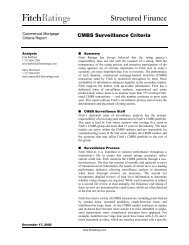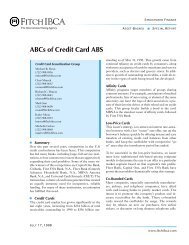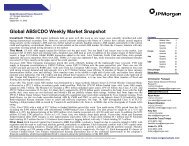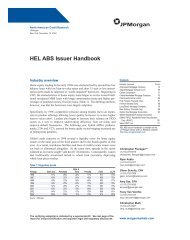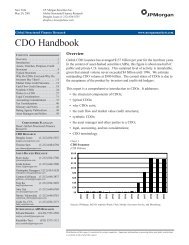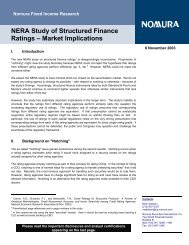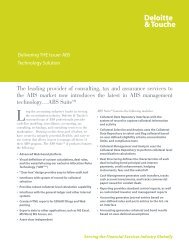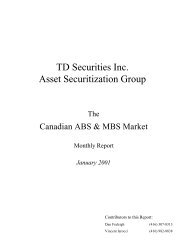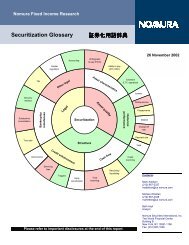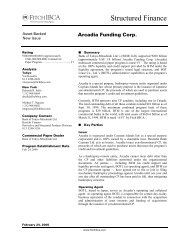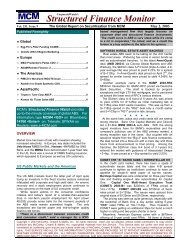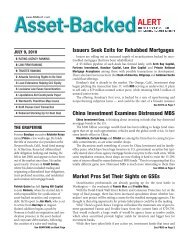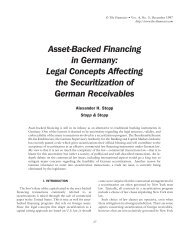Evolution of Amortizing Asset Securitization - Securitization.Net
Evolution of Amortizing Asset Securitization - Securitization.Net
Evolution of Amortizing Asset Securitization - Securitization.Net
Create successful ePaper yourself
Turn your PDF publications into a flip-book with our unique Google optimized e-Paper software.
Canadian ABS/MBS<br />
Research<br />
www.cibcwm.com/research<br />
SECURITIZATION FILES April 10, 2000<br />
Peter Weldon<br />
416-956-3211<br />
Funding long<br />
term amortizing<br />
assets is a<br />
structuring<br />
challenge<br />
• Semi-annual<br />
pay bullets,<br />
rather than<br />
amortizing<br />
notes, are most<br />
favoured by<br />
investors<br />
Nature <strong>of</strong> the<br />
challenge<br />
• <strong>Securitization</strong> <strong>of</strong><br />
amortizing<br />
assets may<br />
result in much<br />
higher carrying<br />
costs associated<br />
with the longer<br />
principal<br />
accumulation<br />
period<br />
<strong>Evolution</strong> <strong>of</strong> <strong>Amortizing</strong> <strong>Asset</strong><br />
<strong>Securitization</strong><br />
Joanna Zapior, CFA<br />
416-594-8498<br />
Tina Lai<br />
416-956-6273<br />
Trevor Bateman,CA<br />
416-594-7992<br />
Ge<strong>of</strong>f Watson, CFA<br />
416-594-8146<br />
Semi-annual pay bullet bonds represent the most liquid type <strong>of</strong> term instrument in the<br />
Canadian capital markets. Semi-annual pay bullet ABS have capitalized on the<br />
preferences <strong>of</strong> Canadian bond investors for structured products with payment<br />
characteristics similar to those <strong>of</strong> government and corporate bonds . This preference is<br />
clearly illustrated in chart #1, where we show that the bullet spread is significantly tighter than<br />
the comparable amortizer spread.<br />
Consumer receivables (credit cards, leases, loans, mortgages, and lines <strong>of</strong> credit)<br />
represent the most readily securitizable assets in any market. They combine the highest<br />
level <strong>of</strong> obligor diversification and homogeneity with the availability <strong>of</strong> long term, historical<br />
performance data. Virtually all consumer receivables are monthly-pay amortizing assets.<br />
Finding cost effective structures to facilitate the funding <strong>of</strong> monthly-pay longer-term<br />
amortizing assets with semi-annual pay bullets represents a critical structuring challenge<br />
in the Canadian market. In our view, future growth in securitization will stem largely from<br />
longer-term monthly-pay amortizing assets. Many <strong>of</strong> these assets reside on the balance sheets<br />
<strong>of</strong> the Schedule I banks.<br />
Until recently, the underlying assets <strong>of</strong> almost all semi-annual pay bullet ABS had been<br />
revolving pools <strong>of</strong> short-term monthly-pay assets such as credit cards, lines <strong>of</strong> credit and<br />
six-month mortgages. Such assets fit the semi-annual pay bullet structure due to the shorter<br />
accumulation periods necessary to repay the principal at maturity, and the resulting low cost <strong>of</strong><br />
carry to the originator. Examples <strong>of</strong> some <strong>of</strong> these structures are in table #1.<br />
Longer-term amortizing assets (mortgages, leases and loans) have proven difficult to<br />
structure as semi-annual pay bullets because <strong>of</strong> the much higher carrying costs associated<br />
with the longer principal accumulation period. Historically, originators <strong>of</strong> longer-term<br />
assets have been precluded from participating in the semi-annual pay bullet ABS market and<br />
forced to rely on less liquid monthly pass-through ABS or the ABCP (commercial paper)<br />
market.<br />
Mortgage, loan and lease securitization has been done with term structures that only dealt<br />
with the prepayability <strong>of</strong> the assets and not the fundamental problem <strong>of</strong> monthly<br />
contractual principal payments. As the securitization market has continued to mature, a<br />
number <strong>of</strong> different structures have emerged. Table #2 briefly summarizes the development<br />
<strong>of</strong> monthly-pay term amortizing structures.
New issue<br />
volumes and<br />
spreads reflect<br />
investor<br />
sentiment<br />
Revolving<br />
pools <strong>of</strong><br />
short-term<br />
assets are<br />
easily<br />
structured to<br />
fund in the<br />
semi-annual<br />
pay bullet<br />
ABS<br />
market…<br />
…and their<br />
desirability is<br />
reflected in<br />
tight spreads<br />
2<br />
Table #1 demonstrates the depth <strong>of</strong> the market for semi-annual pay bullet ABS, in which<br />
issuance since 1997 has exceeded $11 billion. Each <strong>of</strong> the deals shown in table #1 was backed<br />
by a revolving pool <strong>of</strong> short-term assets, allowing the structure to remain efficient for the<br />
originator while satisfying the expectations <strong>of</strong> investors.<br />
Chart #1 shows how spreads are wider for Pride Trust, a monthly-pay pool <strong>of</strong> high quality<br />
mortgages written by HSBC Bank <strong>of</strong> Canada, than they are for Golden Credit Card Trust, a<br />
semi-annual pay pool <strong>of</strong> credit card receivables generated by the Royal Bank <strong>of</strong> Canada. It<br />
appears that structure dictates spreads to a large degree.<br />
Table #1 - Chronology <strong>of</strong> Semi-Annual Pay Bullet Bonds Backed by Revolving<br />
<strong>Asset</strong>s Since 1997<br />
Issue Originator <strong>Asset</strong> Class Amount<br />
Master Credit Card Trust Bank <strong>of</strong> Montreal Credit card receivables 2,000mm<br />
Canadian Credit Card Trust National Bank <strong>of</strong> Canada Credit card receivables 700mm<br />
Cards Trust Canadian Imperial Bank Credit card receivables 1,325mm<br />
<strong>of</strong> Commerce<br />
York Receivables Trust Toronto Dominion Bank Credit card receivables 1,125mm<br />
Sears Canada Receivables Trust Sears Canada Inc. Credit card receivables 600mm<br />
Trillium Credit Card Trust Bank <strong>of</strong> Nova Scotia Credit card receivables 940mm<br />
Canadian Residential Mortgage Canada Trustco<br />
Six-month mortgages 257mm<br />
Trust (CRMT)<br />
Mortgage Company<br />
Golden Credit Card Trust Royal Bank <strong>of</strong> Canada Credit card receivables 1,100mm<br />
Canadian Tire Receivables Trust Canadian Tire<br />
Acceptance Limited<br />
Credit card receivables 200mm<br />
Hollis Receivables Term Trust Bank <strong>of</strong> Nova Scotia Personal lines <strong>of</strong> credit 2,090mm<br />
Genesis Trust Canada Trustco<br />
Mortgage Company<br />
Personal lines <strong>of</strong> credit 1,820mm<br />
Note : Sears total is 925mm, 600mm <strong>of</strong> which has been completed since 1997<br />
Chart #1 - Spread Comparison Between Monthly-Pay Amortizer and Semi-<br />
Annual Bullet<br />
63<br />
58<br />
53<br />
48<br />
43<br />
38<br />
33<br />
Pride Trust<br />
Golden Credit Card Trust<br />
November-99 January-00 March-00<br />
CIBC World Markets<br />
April 10, 2000
The<br />
challenge for<br />
structurers<br />
has been to<br />
satisfy the<br />
needs <strong>of</strong> both<br />
the originator<br />
and the<br />
investor<br />
• Cost<br />
efficiency<br />
versus cash<br />
flow certainty<br />
and liquidity<br />
Recent<br />
structures<br />
reflect the<br />
investor<br />
preference for<br />
semi-annual<br />
pay bullets<br />
3<br />
The structural evolution <strong>of</strong> funding <strong>of</strong> longer-term assets is shown in table #2. The structures<br />
have continued to reflect the trade-<strong>of</strong>f between the needs <strong>of</strong> the originator, which can be<br />
summarized as “cost efficiency” and those <strong>of</strong> the investors, which boil down to “cash flow<br />
certainty and liquidity”.<br />
Table #2 – Structural <strong>Evolution</strong> <strong>of</strong> Monthly <strong>Amortizing</strong> Structures<br />
Pay-Through with Accumulation Accounts – Ace Trust (1993)<br />
In this structure the term note repayment occurred according to a fixed amortization schedule, and a cash<br />
reserve account collected excess cash flow from assets. Term debt did not amortize until short-term debt<br />
was repaid. The pay-through structure gave investors certainty as to the timing <strong>of</strong> cash flows but was<br />
expensive for the originator who assumed the prepayment risk.<br />
Pass-Through Notes – Fairview Trust (1994)<br />
In the pass-through structure the prepayment risk was passed on to the investor. Excess cash was used to<br />
repay short-term debt, then the term notes. The defining feature was the absence <strong>of</strong> cash buildup in the<br />
accumulation account making the structure efficient for the originator. Liquidity was limited for this type<br />
<strong>of</strong> structure given the small group <strong>of</strong> investors willing to assume the uncertain timing <strong>of</strong> cash flows.<br />
Sequential-Pass-through Notes – Case Canada Receivables Inc. (1995)<br />
A series <strong>of</strong> three issues <strong>of</strong> senior and subordinated co-ownership certificates, each <strong>of</strong> which was effectively<br />
a pass-through note. The cash accumulation problem was remedied for the originator but investors bore<br />
some <strong>of</strong> the prepayment risk.<br />
Pay-Through/Pass-Through – Pride Trust (1999)<br />
This issue amounted to a hybrid <strong>of</strong> the two structures with 70% <strong>of</strong> the pool funded with pay-through notes<br />
and the remaining 30% funded with a pass-through <strong>of</strong>fering. The pay-through notes marketed to investors<br />
were monthly-pay amortizing notes. The fixed amortization schedule for the pay-through notes was<br />
protected from prepayments by the pass-through notes which absorbed all incremental principal payments<br />
until they were paid down, and a swap with a “AA” counter party.<br />
As the frequency <strong>of</strong> semi-annual pay bullet ABS issuance has increased over the last two years,<br />
capacity for monthly-pay amortizing structures has contracted and spreads continue to be<br />
wide relative to the more liquid semi-annual pay bullet ABS issues. In order to return greater<br />
efficiency to the funding <strong>of</strong> longer-term monthly-pay amortizing assets, structures can be<br />
created that protect investors from prepayments and retire maturing semi-annual pay<br />
bullet bonds with asset-backed commercial paper. These structures maximize the portion<br />
<strong>of</strong> total funding that enjoys the liquidity <strong>of</strong> the bullet bond market and minimize the<br />
negative carry associated with the amortizing nature <strong>of</strong> the assets. One such example is<br />
the HART issue described in the next section.<br />
Structures such as HART should be as attractive to investors as the revolving pool semi-annual<br />
pay bullet ABS structures. Both are high quality (“AAA”) and will benefit from the increasing<br />
demand for highly rated semi-annual pay bullet bonds.<br />
Despite having the highest credit rating available, revolving semi-annual pay bullet ABS<br />
structures trade at a yield spread over Government <strong>of</strong> Canada benchmarks. This reflects a<br />
structuring premium that arises, at least in part, from the interest rate risk introduced by the<br />
presence <strong>of</strong> the early amortization mechanism required for a “AAA” rating. Longer-term<br />
monthly-pay amortizing structures cannot accommodate, nor do they require, early<br />
amortization.<br />
Accordingly, assuming identical credit quality as reflected by the identical ratings and the<br />
development <strong>of</strong> market liquidity at least equal to bank-originated, revolving pool semi-annual<br />
pay bullet ABS issues completed to date, it is plausible that these new semi-annual pay bullet<br />
structures could ultimately trade tighter than the revolving pool semi-annual pay bullets.<br />
CIBC World Markets<br />
April 10, 2000
HART features<br />
semi-annual<br />
pay bullets and<br />
is structured to<br />
a “AAA” rating<br />
level<br />
HART has been<br />
designed as a<br />
semi-annual<br />
pay bullet to<br />
satisfy<br />
increased<br />
demand for this<br />
type <strong>of</strong> bond<br />
• Funds from<br />
scheduled and<br />
unscheduled<br />
prepayments will<br />
be used to<br />
reduce<br />
commercial<br />
paper<br />
outstanding<br />
• The key<br />
structural<br />
evolution is the<br />
retiring <strong>of</strong> the<br />
semi-annual pay<br />
bullet bonds via<br />
the issuance <strong>of</strong><br />
commercial<br />
paper<br />
Potential size<br />
constraint is<br />
<strong>of</strong>fset by the<br />
size <strong>of</strong> the<br />
potential asset<br />
pool<br />
4<br />
The HART structure is designed specifically to tap into the demand for semi-annual pay bullet<br />
bonds by using a combination <strong>of</strong> commercial paper and an accumulation account to mitigate<br />
the risks associated with monthly-pay amortizing assets that typically require holding excess<br />
cash in the structure.<br />
HART is backed by a low loss portfolio <strong>of</strong> auto loans and is structured to the “AAA” rating<br />
level using standard credit enhancement features. These include 4% overcollateralization, a 1%<br />
cash account and a yield supplement amount that synthetically creates excess portfolio spread<br />
equal to 1%.<br />
HART acquired, using the proceeds <strong>of</strong> the sale <strong>of</strong> securities, two co-ownership interests in<br />
purchased loans (net book value <strong>of</strong> $499,996,757), the support account and the yield<br />
supplement amount. The proceeds <strong>of</strong> the sale <strong>of</strong> the semi-annual pay bullet Series 2000-1,<br />
Class A-1 and Class A-2 Notes were used to purchase the 2000-1 co-ownership interest.<br />
A second co-ownership interest (the Series A Co-Ownership Interest) was purchased through<br />
the issuance <strong>of</strong> $280,769,231 <strong>of</strong> Series A Notes, which consist <strong>of</strong> asset-backed commercial<br />
paper issued by HART.<br />
As the Trust receives both scheduled and unscheduled principal payments, the funds will be<br />
used to pay down the commercial paper. The possibility <strong>of</strong> negative carry exists in the event<br />
that prepayments are faster than expected such that the commercial paper is paid down more<br />
quickly than anticipated. If this occurs, the excess will be held in an accumulation account and<br />
used to make the bullet maturity payments on the Notes as required.<br />
The risk <strong>of</strong> investments made with the cash balances in the accumulation account yielding less<br />
than the weighted average coupon payable is eliminated through a swap with a “AA” rated<br />
financial institution. The floating rate on the investments is paid out in favor <strong>of</strong> receiving a<br />
fixed rate equal to the weighted average coupon rate on the Notes.<br />
The bullet principal maturity payments will be made to investors on the targeted principal<br />
distribution dates. On these dates, HART will use the balance in the accumulation account, if<br />
any, and the proceeds <strong>of</strong> issuance <strong>of</strong> additional Series A commercial paper, as necessary, to<br />
make the required principal payment. Any risk that HART will not be able to raise additional<br />
Series A commercial paper is mitigated through a committed refinancing facility provided by<br />
two “AA” rated banks. Retiring the semi-annual pay bullet bonds via the issuance <strong>of</strong><br />
commercial paper is a significant structural innovation, in that it permits HART to make<br />
the bullet maturity payments with little risk that significant amounts <strong>of</strong> cash will need to<br />
be accumulated and held within the structure. The potential cost <strong>of</strong> negative carry for the<br />
originator is reduced and the investor appetite for semi-annual pay bullet ABS is met.<br />
The HART structure ensures that the <strong>of</strong>fering provides safety <strong>of</strong> principal and eliminates much<br />
<strong>of</strong> the re-investment risk <strong>of</strong>ten associated with securitized long-term amortizing assets. One<br />
constraint for a structure such as this is the relatively small size <strong>of</strong> the issue. The need for<br />
commercial paper tranches large enough to absorb all scheduled and unscheduled principal<br />
payments limits the portion <strong>of</strong> an asset portfolio that can be funded with semi-annual pay bullet<br />
ABS. Nevertheless, the size <strong>of</strong> the monthly-pay amortizing asset pools in Canada indicates that<br />
there is significant potential for the continued <strong>of</strong>fering <strong>of</strong> securities <strong>of</strong> this nature.<br />
CIBC World Markets<br />
April 10, 2000
This report is issued by (i) in Canada, CIBC World Markets Inc., a member <strong>of</strong> the IDA and CIPF, (ii) in the US,<br />
CIBC World Markets Corp., a member <strong>of</strong> the NYSE and SIPC, and (iii) in the UK, CIBC World Markets<br />
International Ltd. or CIBC World Markets plc, each <strong>of</strong> which is regulated by the SFA. Any questions should be<br />
directed to your sales representative. Every province in Canada, state in the US, and most countries throughout<br />
the world have their own laws regulating the types <strong>of</strong> securities and other investment products which may be<br />
<strong>of</strong>fered to their residents, as well as the process for doing so. As a result, some <strong>of</strong> the securities discussed in this<br />
report may not be available to every interested investor. Accordingly, this report is provided for informational<br />
purposes only, and does not constitute an <strong>of</strong>fer or solicitation to buy or sell any securities discussed herein in any<br />
jurisdiction where such would be prohibited. No part <strong>of</strong> any report may be reproduced in any manner without the<br />
prior written permission <strong>of</strong> CIBC World Markets. The information and any statistical data contained herein have<br />
been obtained from sources which we believe to be reliable, but we do not represent that they are accurate or<br />
complete, and should not be relied upon as such. All opinions expressed and data provided herein are subject to<br />
change without notice. A CIBC World Markets company or its shareholders, directors, <strong>of</strong>ficers and/or employees<br />
may have a long or short position or deal as principal in the securities discussed herein, related securities or in<br />
options, futures or other derivative instruments based thereon. A CIBC World Markets company may have acted<br />
as initial purchaser or placement agent for a private placement <strong>of</strong> any <strong>of</strong> the securities <strong>of</strong> any company mentioned<br />
in this report, may from time to time solicit from or perform financial advisory, investment banking or other<br />
services for such company, or have lending or other credit relationships with the same. The securities mentioned<br />
in this report may not be suitable for all types <strong>of</strong> investors; their prices, value and/or the income they produce may<br />
fluctuate and/or be adversely affected by exchange rates. Since the levels and bases <strong>of</strong> taxation can change, any<br />
reference in this report to the impact <strong>of</strong> taxation should not be construed as <strong>of</strong>fering tax advice; as with any<br />
transaction having potential tax implications, clients should consult with their own tax advisors. Past performance<br />
is no guarantee <strong>of</strong> future results. For private clients in the UK: Investors should seek the advice <strong>of</strong> an investment<br />
advisor if they have any doubts about the suitability <strong>of</strong> an investment. Although each company issuing this report<br />
is a wholly-owned subsidiary <strong>of</strong> Canadian Imperial Bank <strong>of</strong> Commerce (“CIBC”), each is solely responsible for<br />
its contractual obligations and commitments, and any securities products <strong>of</strong>fered or recommended to or purchased<br />
or sold in any client accounts (i) will not be insured by the Federal Deposit Insurance Corporation, the Canada<br />
Deposit Insurance Corporation or other similar deposit insurance, (ii) will not be deposits or other obligations <strong>of</strong><br />
CIBC, (iii) will not be endorsed or guaranteed by CIBC, and (iv) will be subject to investment risks, including<br />
possible loss <strong>of</strong> the principal invested. The CIBC trademark is used under license. ©1999 CIBC World Markets<br />
Corp. and CIBC World Markets Inc. All rights reserved.<br />
5<br />
CIBC World Markets<br />
April 10, 2000



